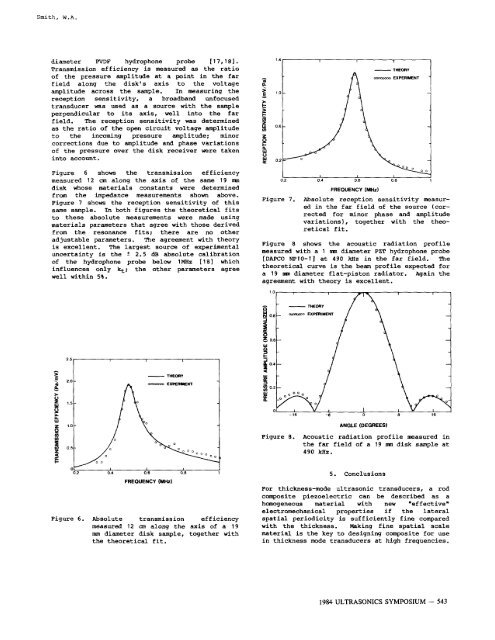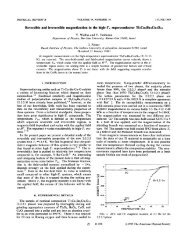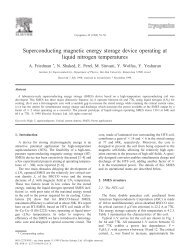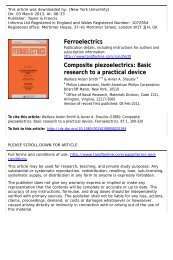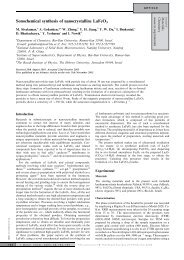Properties of Composite Piezoelectric Materials for Ultrasonic ...
Properties of Composite Piezoelectric Materials for Ultrasonic ...
Properties of Composite Piezoelectric Materials for Ultrasonic ...
You also want an ePaper? Increase the reach of your titles
YUMPU automatically turns print PDFs into web optimized ePapers that Google loves.
Smith, W.A.<br />
diameter WDF hydrophone probe [ 1 7,18 1.<br />
Transmission efficiency is measured as the ratio<br />
<strong>of</strong> the pressure amplitude at a point in the far<br />
field along the disk's axis to the voltage<br />
amplitude across the sample. In measuring the<br />
reception sensitivity, a broadband unfocused<br />
transducer was used as a source with the sample<br />
perpendicular to its axis, well into the far<br />
field. The reception sensitivity was determined<br />
as the ratio <strong>of</strong> the open circuit voltage amplitude<br />
to the incoming pressure amplitude; minor<br />
corrections due to amplitude and phase variations<br />
<strong>of</strong> the pressure over the disk receiver were taken<br />
into account.<br />
Figure 6 shows the transmission efficiency<br />
measured 12 an along the axis <strong>of</strong> the same 19 w<br />
disk whose materials constants were determined<br />
from the impedance measurements shown above.<br />
Figure 7 shows the reception sensitivity <strong>of</strong> this<br />
same sample. In both figures the theoretical fits<br />
to these absolute measurements were made using<br />
materials parameters that agree with those derived<br />
from the resonance fits; there are no other<br />
ad justable parameters. "be agreement with theory<br />
is excellent. The largest source <strong>of</strong> experimental<br />
uncertainty is the 2 2.5 dB absolute calibration<br />
<strong>of</strong> the hydrophone probe below lMHz 1181 which<br />
influences only +; the other parameters agree<br />
well within 5%.<br />
FREQUENCY (MHz)<br />
- THEORY<br />
~caowm EXPERIMENT<br />
Figure 7. Absolute reception sensitivity measured<br />
in the far field <strong>of</strong> the source (corrected<br />
<strong>for</strong> minor phase and amplitude<br />
variations), together with the theoretical<br />
fit.<br />
Figure 8 shows the acoustic radiation pr<strong>of</strong>ile<br />
measured with a 1 w diameter PZT hydrophone probe<br />
[DAPCO NPIO-11 at 490 kAz in the far field. The<br />
theoretical curve is the beam pr<strong>of</strong>ile expected <strong>for</strong><br />
a 19 rmn diameter flat-piston radiator. Again the<br />
agreement with theory is excellent.<br />
- THEORY<br />
25 , I I<br />
- TIIErnY<br />
L<br />
$<br />
Y<br />
B w<br />
Figure 8.<br />
-16 -8 0 8 16<br />
ANGLE (DEGREES)<br />
Acoustic radiation pr<strong>of</strong>ile measured in<br />
the far field <strong>of</strong> a 19 mn disk sample at<br />
490 kHz.<br />
FREQUENCY (MHz)<br />
Figure 6. Absolute transmission efficiency<br />
measured 12 cm along the axis <strong>of</strong> a 19<br />
nun diameter disk sample, together with<br />
the theoretical fit.<br />
5. Conclusions<br />
For thickness-mode ultrasonic transducers, a rod<br />
composite piezoelectric can be described as a<br />
homogeneous material with new "effective"<br />
electromechanical properties if the lateral<br />
spatial periodicity is sufficiently fine compared<br />
with the thickness. Making fine spatial scale<br />
material is the key to designing composite <strong>for</strong> use<br />
in thickness mode transducers at high frequencies.<br />
1984 ULTRASONICS SYMPOSIUM - 543


